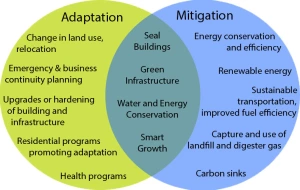 I’m about to complete a wonderful class on climate change and these last weeks, in particular, have provided a great source of tips on how to deal with the biggest challenge humanity AND the planet face today (and increasingly will do in the future).
I’m about to complete a wonderful class on climate change and these last weeks, in particular, have provided a great source of tips on how to deal with the biggest challenge humanity AND the planet face today (and increasingly will do in the future).
Within two months I had the chance to delve into the scientific aspects of WHY and HOW human activity modified the environmental equilibrium of our planet and what this means for our communities. Policy-making being my main field of interest, I strongly appreciated the variety and richness of suggestions and examples from all over the world on how to cope with climate change. Here I will share with you a tiny part of this vast and evolving knowledge:
- Climate change mitigation essentially means dealing with the causes.
- There are three main mitigation policy-types:
- Voluntary measures
- Command and control/Regulatory policies
- Market mechanisms
- Voluntary approaches deem information as the crucial element, and so take the form of efforts to raise awareness. The problem is that information is not the only thing we need to act, because it can actually be polarizing and people tend to pick and choose what information they listen to. This approach had a modest effect, more is needed.
- The command and control approach is basically the opposite of the voluntary one. It is about putting limits on the amount of greenhouse gases a company is allowed to emit. Downsizes: regulations can be extremely costly to enforce and they don’t really change the structure of the market to incentivize innovation.
- Market-based approaches aim at bringing the private costs that a firm faces into line with the social costs of that firm doing business. So that there’s an economic incentive for polluters to reduce its emissions. This approach can target also individuals, as consumers, and allow them to decide how they prefer to avoid the costs associated with their actions. It is about triggering the demand-side and the supply-side of mitigation strategies. Examples are:
- Carbon tax: placed on each unit of GHGs emitted. It can target companies, communities, or even individuals. Two points are crucial: if the level it’s too low, it won’t have any effect on behavior. If it’s too high, it’ll unfairly penalize companies or households and could significantly impact profits and jobs and personal financial security. Often it starts low and increases each year. It may be revenue-neutral or not.
- Cap-and-trade: a “cap” is set on a total allowable emissions, permits to emit GHGs are distributed to emitters, some firms will need more permits, and so will have to buy, other firms will find it easier to reduce their emissions, and so will have permits to sell. A crucial decision is the initial allocation.
- Adaptation is a form of risk-management.
- The vast majority of adaptation policies are local or regional, rather than national or international (see this example and this one). They are rarely undertaken only in response to climate change, but rather blur with development initiatives, management of risks associated with extreme weather events and natural disasters, habitat conservation and agricultural policy.
- Four main categories of adaptive responses:
- Ecosystem conservation (i.e. changing crops, irrigation systems)
- Development support (provide support for less-developed countries in the form of literacy programs, food and water provision)
- Preparing for change (flood defenses, refugee support, city planning, stock piling vaccines)
- Learning more (better emissions and impact scenarios, participatory scenario development which involves not only scientists).
- Four common climate action barriers:
- Lack of funding
- Electoral cycle swings
- Human resources
- Lack of internal leadership
These can be overcome by accessing support, integrating climate action into existing municipal operations, and generating a business case for climate action.
- Some crucial questions that guide adaptation policy management:
- What are the existing methods for managing climate risks and adaptation? Are these visible in the future? Can they be built upon?
- What other interventions can be utilized to reduce impacts and improve development impacts?
- Can these adaptation interventions be undertaken? What are the barriers?
- What are the costs, impacts and barriers of each option (based on agreed criteria)?
- How do the options compare through ranking?
- What suite of policies and measures constitutes a cohesive approach to development and adaptation?
7 thoughts on “Notes on Climate Change Adaptation and Mitigation Strategies”